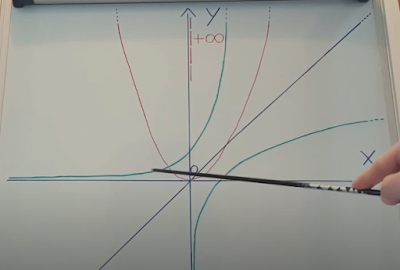Nicolò Vignatavan - Limits at infinity (ENG)
LIMITS AT
INFINITY
[Throughout
history, the concept of infinity has played a pivotal role in the game in which
human
beings
have always taken part against their unfulfilled thirst for knowledge.
Philosophers,
mathematicians
and poets of various eras have proposed their interpretation in this
regard:
Giordano
Bruno proposed a testimony of faith; Kurt Godel, the proof of a logical
incompleteness
and
Giacomo Leopardi, overcoming finiteness (finitude). Today I will analyze the
concept of
"infinity",
reduced two-dimensionally on the Cartesian plane, comparing the trend of the
fundamental
mathematical functions graphically by introducing the symbology of "plus
infinity
minus".]
According to
the theory of the hierarchy of infinities, taking into consideration the first
quadrant of
the Cartesian plane, and, assuming one draws the graph of the function of an
increasing
oblique straight line y = mx + q, of a parabolic function y = ax ^ 2, with term
a> 0, of a
logarithmic
function y = log (x) and of an exponential function y = a ^ x,
it is evident
how the calculation of the limit for x which tends to + oo of all the
functions
described above corresponds to + oo.
Always
according to the theory of traditional mathematics, it is evident that the 4
functions
mentioned above
do not tend towards + infinity with the same speed, but with a
displacement
[delta (y)] different according to their intrinsic characteristics, although
they
tend, on the
whole, to + infinity, without stabilizing at any point value of y, along their
path. It is
always evident
that the order of growth
rate towards y, in the first quadrant, for x tending to +
infinity, of the 4 functions is, from the fastest
growing to the slowest growing, the following:
1st: exponential
function, 2nd: parabolic function, 3rd: straight function, 4th: logarithmic
function.
Let us assume
the result + infinity of the calculation of the limit for x that tends to + oo,
that of an
imaginary
function that moves perfectly asymptotically towards the y axis. If the result of the
calculation of
the limit for x which tends to + infinity of the exponential function described
above,
among the 4
functions considered is the one that comes closest to the characteristics of
the
pure solution
+ oo of the imaginary function described above, or in other words it is the one
whose graphic
path for x that tends to + oo moves more rapidly towards the y axis, then the
result of the
limit will be considered as + oo ^ (-).
At this point, adding (-) at the apex of (+ oo) we
will have as
results of the limits for x
which tends to
+ oo of the functions described above:
exponential
function: + oo ^ (-)
parabolic function:
+ oo ^ (--)
linear
function: + oo ^ (---)
logarithmic
function: + oo ^ (----).

Commenti
Posta un commento